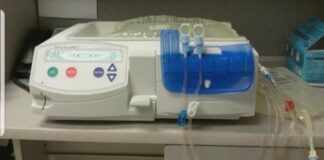Tag: dialysis
A Brief Look at Peritoneal Dialysis
Did you know that many patients with kidney failure are able to home dialysis on their schedule? The most popular home dialysis is called peritoneal dialysis, or PD. With PD, you’ll go to the clinic just a couple of times a month to meet with your care team. The rest of your dialysis is done at home. So, you may ask what exactly is peritoneal dialysis or PD? Let’s take a look at what is peritoneal dialysis and how does it work.
The Importance of Not Shortening Your Dialysis Treatment
There are thousands of patients across the world that attend outpatient hemodialysis for kidney failure. However, many of these patients unfortunately shorten their dialysis treatment time for various reasons such as not feeling well, cramping, doctor appointment, work related, family issues and other various reasons.
Infection Risks: How to minimize them?
Thousands of patients each day undergo kidney dialysis treatment across the United States. These patients are at an increased risk for infection because the hemodialysis process requires frequent use of catheters or needles to access the bloodstream. Patients who undergo hemodialysis have weakened immune systems, which increase their risk for infection. They require frequent hospitalizations and surgery where they might acquire an infection.
Chronic Kidney Disease & the Risk of a Stroke
Did you know that patients with kidney disease are at risk of having a stroke, which is a leading cause of morbidity and mortality worldwide? In fact, the risk of stroke is 5-30 times higher in patients with chronic kidney disease, especially on dialysis. So, what exactly is a stroke?
The Importance of a Good Blood Flow during hemodialysis.
Healthy kidneys clean the blood 24/7. During each minute of every day, around one quart (1000ml) of blood passes through the kidney. Considering its small size, this is a huge amount of blood, much more than is received by any other organ in the body. The total blood volume of an adult is around 5-7 quarts, so it takes only minutes for one’s entire blood supply to pass through the kidney, and more and more of the body’s wastes are cleared from the blood.
Tips for Fluid Control: What You Need to Know
Many new patients starting dialysis treatment have a hard time controlling their fluid intake. Controlling thirst can decrease the amount of fluid consumed and help achieve fluid goals.
Protein: Tips for People with Chronic Kidney Disease?
Patients with chronic kidney disease often hear the words from their dietician either decrease or increase your protein intake. Depending on what stage of chronic kidney disease they have. What exactly is protein, and why is it important for people with chronic kidney disease?
What is Kt/V and What you Should Know?
*These statements have not been evaluated by the US Food and Drug Administration. This information is not intended to diagnose, treat, cure, or prevent...
Patient Safety during outpatient hemodialysis: What does it mean?
*These statements have not been evaluated by the US Food and Drug Administration. This information is not intended to diagnose, treat, cure, or prevent...
Tips for Heparin: Why is it used for hemodialysis?
*These statements have not been evaluated by the US Food and Drug Administration. This information is not intended to diagnose, treat, cure, or prevent...










